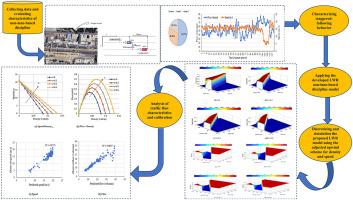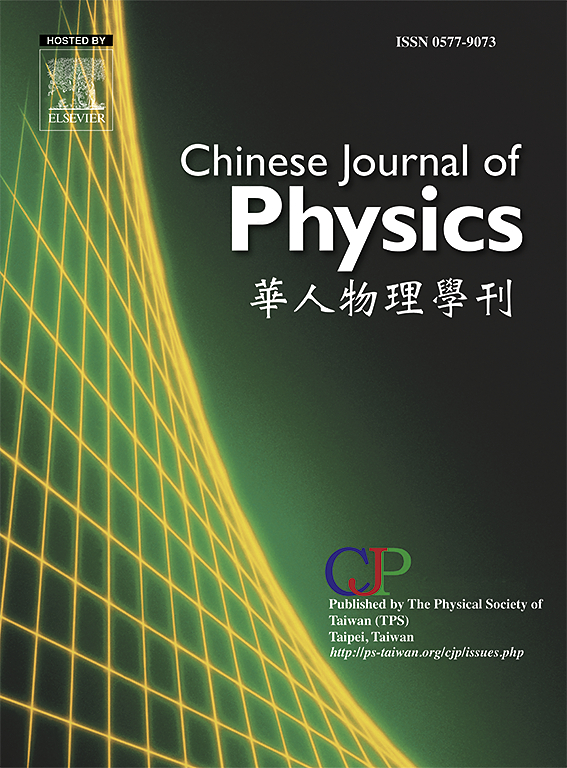考虑驾驶员行为的轻型车辆交通流分析扩展LWR非车道学科模型
IF 4.6
2区 物理与天体物理
Q1 PHYSICS, MULTIDISCIPLINARY
引用次数: 0
摘要
在交通流中,非车道约束是一种常见的驾驶行为,特别是在伊朗等发展中国家。在这种情况下,驾驶行为会发生变化,影响整体交通动态,使交通流预测变得更加复杂。这种复杂性导致了对车道容量的不准确估计。为了改进非车道交通条件下的流量预测,本研究首先考察了非车道交通的动态交通特征,重点研究了伊朗德黑兰城市多车道高速公路的微观变量,如横向分离距离(LSD)和车头时距。其次,提出了一种扩展的LWR模型来分析LSD对交通流特性的影响。采用调整后的迎风方案进行了数值模拟,并对该方案进行了稳定性分析。该模型使用来自伊朗的现场数据进行了验证,特别是针对轻型车辆(lv)。结果表明,在交错跟随行为下,随着LSD值的增加,低电压驾驶员的时间超前减小。所提出的LWR模型有效地模拟了密度和速度演化的平滑过渡,捕获了中间车道的激波和稀疏波。在非车道约束条件下,该模型准确地反映了激波在阻塞阶段的逐渐减速和稀疏波在自由流动状态下的逐渐加速。这些转换反映了现实世界的连续交通流,防止了lv的突然加速和减速。在LSD参数最大的非车道交通条件下,车道容量和中间车道拥堵密度分别比车道增加61%和60%。利用真实世界的数据验证了该模型的模拟结果,证明了其在预测非车道约束对交通流影响方面的有效性。本文章由计算机程序翻译,如有差异,请以英文原文为准。

An extended LWR non-lane-based-discipline model for light vehicle traffic flow analysis incorporating driver behavior
Non-lane-based discipline is a common driving behavior in traffic flow, particularly in developing countries such as Iran. Under these conditions, driving behaviors change, affecting overall traffic dynamics and making traffic flow prediction more complex. This complexity leads to inaccurate estimates of lane capacity. To improve flow prediction under non-lane-based traffic conditions, this study first examines the dynamic traffic characteristics of non-lane-based discipline, focusing on microscopic variables such as lateral separation distance (LSD) and time headway on an urban multilane highway in Tehran, Iran. Second, an extended Lighthill-Whitham-Richards (LWR) model is proposed to analyze the effects of LSD on traffic flow characteristics. Numerical simulations are conducted using an adjusted upwind scheme, and a stability analysis is performed for the scheme. The model is validated using field data from Iran, specifically for light vehicles (LVs). The results indicate that, under staggered-following behavior, time headways of LV drivers decrease as LSD values increase. The proposed LWR model effectively simulates smooth transitions in density and speed evolution, capturing shock and rarefaction waves in the middle lane. Under non-lane-based discipline, the model accurately represents the gradual deceleration in the jam phase for shock waves and the gradual acceleration in the free flow condition for rarefaction waves. These transitions reflect the real-world continuous traffic flow, preventing sudden acceleration and deceleration of LVs. Furthermore, under non-lane-based traffic conditions with the maximum LSD parameter, lane capacity and jam density in the middle lane increase by 61% and 60%, respectively, compared to lane-based conditions. The model's simulated results were validated using real-world data, demonstrating its effectiveness in predicting the impact of non-lane-based discipline on traffic flow.
求助全文
通过发布文献求助,成功后即可免费获取论文全文。
去求助
来源期刊

Chinese Journal of Physics
物理-物理:综合
CiteScore
8.50
自引率
10.00%
发文量
361
审稿时长
44 days
期刊介绍:
The Chinese Journal of Physics publishes important advances in various branches in physics, including statistical and biophysical physics, condensed matter physics, atomic/molecular physics, optics, particle physics and nuclear physics.
The editors welcome manuscripts on:
-General Physics: Statistical and Quantum Mechanics, etc.-
Gravitation and Astrophysics-
Elementary Particles and Fields-
Nuclear Physics-
Atomic, Molecular, and Optical Physics-
Quantum Information and Quantum Computation-
Fluid Dynamics, Nonlinear Dynamics, Chaos, and Complex Networks-
Plasma and Beam Physics-
Condensed Matter: Structure, etc.-
Condensed Matter: Electronic Properties, etc.-
Polymer, Soft Matter, Biological, and Interdisciplinary Physics.
CJP publishes regular research papers, feature articles and review papers.
 求助内容:
求助内容: 应助结果提醒方式:
应助结果提醒方式:


